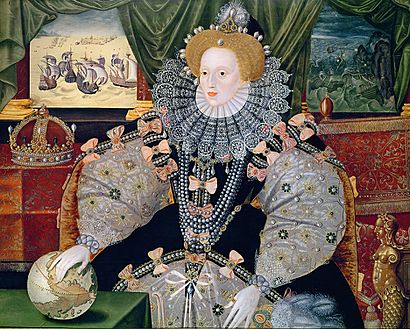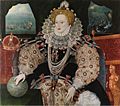Armada Portrait facts for kids
Quick facts for kids Armada Portrait |
|
|---|---|
 |
|
| Artist | Unknown English artist (formerly attributed to George Gower) |
| Year | 1588 |
| Type | Oil on oak panel |
| Location | Woburn Abbey |
The Armada Portrait of Elizabeth I of England is a very famous painting. It shows Queen Elizabeth I surrounded by important symbols of her royal power. In the background, you can see scenes from the defeat of the Spanish Armada in 1588. This painting is an allegory, meaning it uses symbols to tell a story or represent ideas. There are three main versions of this portrait that still exist today.
What the Painting Means (Iconography)
This painting is special because it shows a life-sized portrait of Elizabeth I with a wide landscape behind her. This was quite new for portraits of the queen at that time.
English art during this period was different from art in other parts of Europe, like Italy. It was more influenced by Flemish illustrated books and coat of arms designs. The 'Armada Portrait' shows this. For example, the chair and tables in the painting are shown from different angles. Also, the background shows two different moments from the defeat of the Armada.
On the left side of the background, you can see English fireships moving towards the Spanish fleet. These fireships were used to set the Spanish ships on fire. On the right side, the Spanish ships are being pushed onto a rocky coast by a big storm. This storm was called the "Protestant Wind" by some, as it helped the English. These images also show Elizabeth turning away from the storm and darkness, while sunlight shines where she looks. This idea was used again in other portraits of the queen, like the "Ditchley" portrait from 1592.
In the painting, the queen's hand rests on a globe. Her fingers are covering the Americas. This shows England's power over the seas and its dreams of starting colonies in new lands. Behind the queen, there are two tall columns. These columns likely refer to the famous symbol of Charles V, who was Philip II's father. His symbol represented the Pillars of Hercules, which were thought to be the edge of the known world.
Art experts have noticed how much geometry is in the painting. You can see repeating patterns of circles and arches in the crown, the globe, and the queen's sleeves, ruff, and gown. The queen is also wearing a large pearl on her bodice. This pearl symbolizes chastity, meaning purity. On the chair, there is a carving of a mermaid. Some believe the mermaid represents dangers or even Queen Mary. Elizabeth is facing away from the mermaid, which might mean she has moved past any problems or plots related to Mary. The crown in the painting also represents the English monarchy.
The chains of pearls Elizabeth wears might be pearls she bought from the collection of Mary, Queen of Scots in 1568.
Different Versions of the Portrait
There are three main versions of the Armada Portrait that still exist today. There are also other paintings that were copied from them:
- The first version is kept at Woburn Abbey.
- Another version is at the National Portrait Gallery, London. This one has been cut down on both sides, so it only shows the queen's face and upper body.
- The third version was owned by the Tyrwhitt-Drake family. It might have been ordered by Sir Francis Drake, a famous English explorer. This version was first recorded in Shardeloes in Buckinghamshire in 1775. Experts believe a different artist painted this version. They have noticed different ways the queen's face was painted. This "Drake" version was also painted over a lot in the late 1600s. This makes it harder to know exactly who painted it and explains some differences in her clothes. This version was bought for the nation for £10.3 million in July 2016. It is now displayed at the Royal Museums Greenwich (RMG), in the Queen's House. This house is a 17th-century royal home built where Greenwich Palace once stood, which was Elizabeth I's birthplace.
The first two portraits were once thought to be painted by Elizabeth's official painter, George Gower. However, experts at the National Portrait Gallery now think that all three versions were made in different art workshops. They now say the artist is "an unknown English artist."
See also




